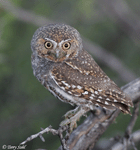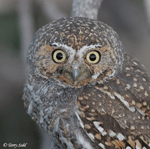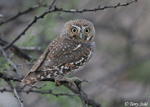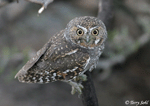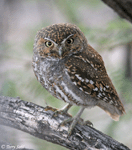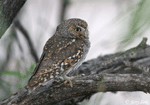| Length: 5.5 inches | Wingspan: 12 inches | Seasonality: Non-resident in South Dakota |
| ID Keys: Tiny size, grayish brown overall with speckling, diffuse streaks on underparts | ||
 The Elf Owl is the smallest owl in the world. They have a relatively small
range, summering in southern Arizona, southern New Mexico, far southwestern
Texas, and parts of northern Mexico, and wintering in western Mexico.
In the U.S. portion of their range, they are most often found in the Sonoran
Desert, where they use woodpecker holes in saguaro cacti for nesting.
They also can be found in forested canyon areas. Due to their small
size, they are incapable of hunting most vertebrates, feeding very
heavily on insects, spiders, and scorpions.
The Elf Owl is the smallest owl in the world. They have a relatively small
range, summering in southern Arizona, southern New Mexico, far southwestern
Texas, and parts of northern Mexico, and wintering in western Mexico.
In the U.S. portion of their range, they are most often found in the Sonoran
Desert, where they use woodpecker holes in saguaro cacti for nesting.
They also can be found in forested canyon areas. Due to their small
size, they are incapable of hunting most vertebrates, feeding very
heavily on insects, spiders, and scorpions.
Habitat: Elf Owls can be found in a variety of lowland habitats, but are most commonly found in saguaro areas of the Sonoran desert, and in forested canyons.
Diet: Mostly feeds on insects, scorpions and spiders. Much less commonly, they will feed on very small lizards or very small rodents.
Behavior: Nocturnal, typically only feeding right at dusk or at night. Elf Owls watch for prey from a perch and then fly out to capture prey when spotted. They can glean insects from foliage or stems of plants, but are also capable of capturing flying insects in mid-air.
Nesting: The nest of an Elf Owl is built in a cavity in a tree or large cactus, most often using an old woodpecker hole. The female alone incubates the eggs, but the male will bring her food during that time. Both parents will help to raise the young, but the male does nearly all the hunting for the first few weeks after the young hatch.
Song: The most commonly heard call of the Elf Owl is a crisp high yap, but they also have other calls, including a soft whistled mewing and a series of toots that ascend and then descend in pitch.
Migration: In the U.S. portion of its range, it is only a summer visitor, as birds move southward into Mexico relatively early in the fall. They are permanent residents throughout parts of their range in Mexico, particularly in Baja California.
Interactive eBird Map: Click here to access an interactive eBird map of Elf Owl sightings
Similar Species: Unlikely to be confused with other owls, if seen well. Possibly confused with Ferruginous Pygmy-Owl in range.
Conservation Status: The IUCN lists the Elf Owl as a species of "Least Concern." In the U.S. portion of its range, it has declined in some locations due to habitat loss.
Further Information: 1) Cornell's Lab of Ornithology - Elf Owl
2) Arizona Sonoran Desert Museum - Elf Owl
3) Owling.com - Elf Owl
Photo Information: May 7th, 2008 - Outskirts of Tucson, Arizona - Terry Sohl
| Click below for a higher-resolution map |
 |
| South Dakota Status: Non-resident in South Dakota |
Additional Elf Owl Photos
Click for a higher-resolution version of these photos
